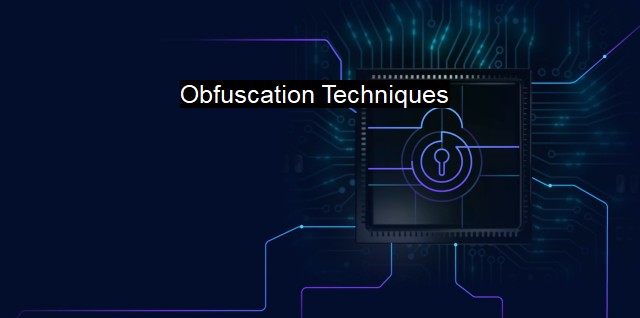What are Obfuscation Techniques?
Staying Hidden in Plain Sight: Understanding the Role of Obfuscation Techniques in Cybersecurity
Obfuscation techniques are a unique category of cybersecurity measures seen as primary tools for malicious software, dedicated to ensuring persistence and evasiveness. These practices can often be seen as a double-edged sword: while they are heavily used in protective programming to maintain software walled off against enlightenment attempts, they also feature significantly among cybercriminals' preferred strategies.At its core, obfuscation involves obscuring code content and its intended purpose, often through confusion or vagueness. This is particularly pivotal in the realm of cybersecurity and antivirus. Developers commonly employ obfuscation techniques to protect proprietary software code, making it less vulnerable to attacks wherein hackers might aim to decode it, identify vulnerabilities, and exploit them to infiltrate systems. By making the code complex or ambiguous, they help in preventing unauthorized and unnecessary alterations to the code, as understanding exactly how it operates becomes an uphill task even for skilled hackers.
As previously suggested, obfuscation's coin has a flipside. Malicious software or viruses can exploit these techniques, using them just as software developers do. The source codes of malware programs are often obfuscated by cybercriminals to bypass antivirus screening processes that base their detections on signature-based models. In this scenario, antivirus software can fail to identify and neutralize threats. Malware authors consequently get the upper hand, ensuring their malicious codes run undetected for extended periods.
Tackling such obfuscated threats can be quite complicated for cybersecurity professionals. The more obfuscated a code is, the harder it becomes for security solutions to analyze and uncover its true functionalities. Some sophisticated malware even come endowed with self-modifying or evolving algorithms capable of continuously altering their own code structures, a reflective process known as polymorphism. Techniques like runtime packers, garbage code insertion, and encryption are plenty among polymorphic and metamorphic viruses, making them notoriously challenging to detect.
Comprehending obfuscation techniques is also critical because of its role in exploit kits used in the process of drive-by downloads. Often, these kits are coded with obfuscation techniques that confuse antivirus securities, thereby enabling adversaries to exploit software vulnerabilities and force innocent users to download harmful content without their knowledge.
Fortunately, cybersecurity companies are squaring off with these challenges in interesting ways. Advanced techniques, like heuristic analysis, are being used to analyze the behavior of a program, instead of merely relying on virus signatures. This type of analysis can often identify virus code, even if it has been obfuscated. Combined with decryption routines and unpacking code that counters encryption, antivirus software has a real chance in battling against obfuscated threats. Even cognitive systems that utilize artificial intelligence are being developed to identify deep-seated malicious behavior patterns that have been concealed with obfuscation.
Obfuscation techniques indeed play a vital role in the continuum of cybersecurity and antivirus strategies. These techniques, paradoxically playful for benevolent roles and catastrophic for malevolent purposes, underscore the relevance of maintaining cyberspace's integrity. They thrust focus on the constant need to devise high potency systems capable of deciphering complex algorithms. Both software developers and customers alike need to stay abreast of the latest obfuscation techniques, not just for furthering winning strategies against cyberattacks, but more importantly, to fathom the depths of this indefinite virtual battlefield.

Obfuscation Techniques FAQs
What are obfuscation techniques in cybersecurity?
Obfuscation techniques in cybersecurity are methods used to hide or obscure the true intent or functionality of software code or files, making them difficult for anti-virus software to detect and analyze.What is the purpose of using obfuscation techniques?
The purpose of using obfuscation techniques is to make it harder for cybercriminals to reverse engineer or analyze software code, making it more difficult for them to find vulnerabilities or create exploits.What are some common obfuscation techniques used in cybersecurity?
Some common obfuscation techniques used in cybersecurity include code scrambling or randomization, string encryption, code obfuscation through the use of misleading variable names, and the use of packers or compressors that make the code more difficult to read and analyze.Can obfuscation techniques completely protect against antivirus detection?
While obfuscation techniques can make it more difficult for antivirus software to detect and analyze malware, they are not foolproof and can often be detected by advanced antivirus algorithms. Therefore, businesses and individuals should not rely solely on obfuscation techniques to protect against cyber threats and should instead use a combination of techniques such as antivirus software, firewalls, and user education.| | A | | | B | | | C | | | D | | | E | | | F | | | G | | | H | | | I | | | J | | | K | | | L | | | M | |
| | N | | | O | | | P | | | Q | | | R | | | S | | | T | | | U | | | V | | | W | | | X | | | Y | | | Z | |
| | 1 | | | 2 | | | 3 | | | 4 | | | 7 | | | 8 | | |||||||